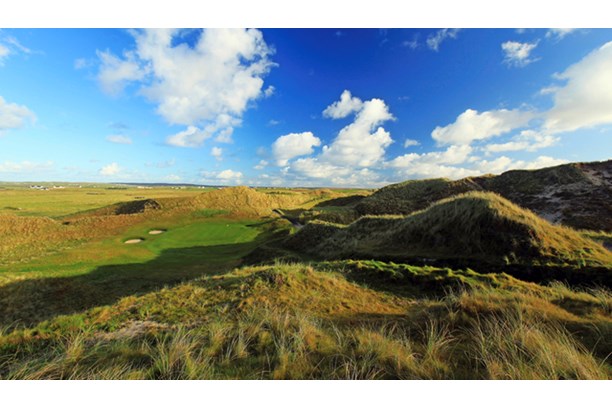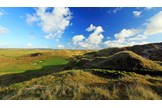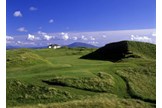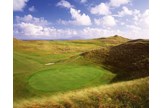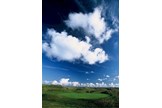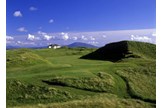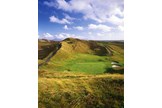Carne Golf Links
Last updated:
What we say
Carne Golf Links is one of the best golf courses around for those who like their links raw and untamed, not preened and manicured.
It is a long road to reach Belmullet, cutting across a desolate landscape of bogs and distant mountains in the far north west of Co. Mayo.
It has been a long road, too, for the 27-hole course that greets you on the Mullet peninsula, attached to Ireland by no more than a narrow spit of land.
How Carne Golf Links came into being is a story of community spirit and determination. Given the enormous dunes that are home to a course that is a fixture in our Top 100 Great Britain & Ireland, it is a tale worth telling.
RELATED: Ballyliffin Golf Club review
It adds to Carne’s mystique and adds to the appreciation of just what has been achieved here, for Carne was created with as minimal an impact on the landscape as possible. That’s saying something when the dunes are so big, crumpled and erratic that it looks as if a giant grabbed the peninsula between his hands and squeezed, until the dunes erupted upwards. At their highest they rise to over 500 feet above sea level.
This story and that of Doonbeg in Co. Clare show the difference in the development of the two newest links on the island.
Doonbeg (2002) was created by an American financial juggernaut, designed by one of the world’s greatest golfers and boasts five-star luxury at every turn.
Carne (1992) was inspired by a community that saw the tourism benefits a golf course would bring. Financially, it was a hand-to-mouth affair. Where Doonbeg is manicured and pristine (and no less brilliant for it), Carne is raw and untamed. It reflects the evolution of the course, the nature of this wild peninsula and the passion and the commitment of the people behind it.
The group of locals who saw the project’s potential in the 1980s, had to convince 17 farmers to sell land covering 260 acres, and then explore every possible government grant and funding mechanism to raise finances. Over £200,000 was raised through local events such as raffles and cake sales. And then the course had to be routed through the dunes.
RELATED: Castlebar Golf Club review
The decision to hire Eddie Hackett to design the course was not only an inspired one it was also the obvious one. A revered Irish architect, Hackett’s hand is in many of the great Irish links, including Waterville, Connemara and Enniscrone. He accepted the job readily and spent days walking the dunes, mapping out his 18 holes. He was almost 80 years of age.
No one believed in letting nature dictate the shape of a golf course quite like Hackett. His philosophy was to let the natural features of the land do the work. “Nature is the best architect, I just dressed up what the good lord provided,” he said.
Stand atop the dunes on any number of tees and you will understand why his philosophy was the right one. Stand on those same dunes and you will also be rewarded with stunning views of islands dotted across the ocean, the Nephin Beg mountain range rising to the south-east and Slievemore standing proud on Achill Island.
The vision of that community group was finally realised when Carne opened in 1992. Hackett passed away shortly afterwards and Carne will surely be his lasting legacy.
But that is not the end of the story, for there is one final twist to Hackett’s swansong. He had seen the potential for more holes and while he never got to design them, his was the inspiration for the next chapter in Carne’s evolution.
The dream of a new nine holes progressed when Jim Engh, an American architect and Carne member, developed a skeleton design in 2004. The financial downturn put a stop to those plans and they were only reignited when a young Scottish golf architect named Ally McIntosh visited the course in 2010.
“It was clear that Carne wanted to progress the project and they needed some help to do so,” says McIntosh of his early visits to Belmullet. “It was also clear that we shared the same concept of how the course could be developed.”
It was to be McIntosh’s first solo design project. He and his partner, James Coughlan, began plotting holes that weaved through the existing and more dramatic back nine, fitting the two nines together as seamlessly as possible – not an easy task given the dramatic elevation changes.
“Staying true to the natural approach was key,” McIntosh emphasises. “We knew that if we did this, the new holes would intermingle organically with the Hackett holes and the 27 would feel part of one interchangeable golf course.”
RELATED: Golf World Top 100 Best Golf Courses & Resorts
Known as the Kilmore nine it was a deliberately slow build, which meant McIntosh and Carne could take their time with the design process to get everything right. The new holes were opened in 2013, and their evolution matches the course’s early history, being built for just £160,000, with no more than a six tonne digger and a dumper. What is so remarkable about the new holes is that they are every bit as dramatic as the old back nine, and perhaps more so.
These new holes now cause Carne a dilemma: do they stick with the original Hackett 18, or do they choose the Hackett back nine and McIntosh’s Kilmore nine? The latter would seem to make sense, given that the two loops weave together so well and are of similar scale. That, however, would be to pass over the original front nine, which, while not as big and dramatic, are every bit as good.
Carne is laid out in three loops of nine, all starting behind the cosy clubhouse and facing into the sea of dunes. You feel like you’re about to be cast adrift.
Hackett’s front nine play over dunes that get smaller in scale as they move farther inland. That’s not to say they are small as they still block views and frame holes, nowhere more so than on the valley descent to the 8th green. It’s an introduction of sorts to the rumpled fairways, the unpredictability that such fairways bring, the natural green sites and the sort of shot-making that will be in much demand as the round progresses.
It also teaches you to expect the unexpected. The par-4 1st is a case in point. It sweeps right, around a dune, with two high ridges stretched across the fairway; hit your drive into the wrong place and the ball will sweep right and down, from where there is no view of the green. The 3rd is one of only three par 4s on the entire course over 400 yards (white tees).
It emphasises that Carne requires more brains than brawn. You’ll recognise this standing on any of the tees. Greens are rarely visible and the fairways twist, turn, rise and fall as you assess the hole ahead of you.
The 5th is a short, straight par four where a sliver of green might be visible through a narrow chute in the dunes. The fairway bumps up and down before you get there, proving deceptive, and anything hit right leaves a treacherous blind shot over the dune top.
The 7th, a par three of 177 yards, presents a green sitting on a sharp incline high above you. Fall short and the ball runs back 50 yards. The 9th is a straight par four but it offers similar risks to the 7th, with steep step-like ridges rising to the green. There’s a high tee and you can judge the dangers for yourself before choosing what club to play.
There is little doubt that Hackett’s back nine is as explosive as a course can be. Hitting onto the 10th fairway, up the slope and flanked between matching dunes, stands as fair warning or what is to come.
Once you drop down the other side, Carne becomes a rollercoaster, where the random, erratic dunes create corridors of shadow and intrigue, and the routing simply follows where the dunes lead.
You head out to the coastline, via the 11th and 12th, two short, sharp doglegs – one right, one left – that both drop from a high tee box before rising sharply to greens, almost on the same level. The 13th and 14th cling to the Atlantic, as wild and desolate as any of the holes here.
Views spill across beaches and dark rock to the islands of Inis Gloire and Geidhewild. This is the farthest corner of the course, before your turn for home and one of the great closing stretches in Irish golf.
From the coastline you are quickly tossed back into the see-sawing of the dunes, down and then up on the 15th, pausing briefly on top of another skyscraper dune to take in the par-3 16th, with the green protected in a tiny hollow below.
The 17th is the longest par four and the most difficult hole at Carne, requiring two mighty blows as you head slowly upwards for 436 yards, with hidden fall-offs left and right.
The par-5 18th has one final, unexpected twist with a blind crater likely to swallow your approach shot.
The Kilmore nine feel even more natural – if that is possible – and nowhere is this more apparent than on the first two holes: the green setting on the 1st is perched on a low ledge, but set above hollows and fall-offs that only nature could have created; the 2nd is a par 3 that plays into a gateway between two dunes. Hidden from the high tee is a vast waste bunker that climbs 30 feet up the side of the right dune. From there you head back into the main complex of dunes, where you interweave with the old back nine.
There are three par 3s on Kilmore – the 2nd, 4th and 7th. The 7th is a hole of terrifying beauty. From the tee, fellow golfers walking through the valley of the 5th hole look like ants and it is one of the best viewpoints on the course. The tee shot is 228 yards, hitting from one dune to another, with only disaster in between. It is the most daunting shot you will hit all day, with or without the wind.
The 8th swings you for home, but the final two holes are just as rumbustious between cordons of unrelenting dunes and fairways of dramatic shape. It is a fitting finish.
The Hackett course plays between 5,855 yards (yellows) and 6,666 yards (blues), while the Kilmore plays between 2,761 and 3,228 yards.
There are many plaudits for the course, and Hackett and McIntosh, obviously, but, when all is said and done, it is the people of Belmullet who deserve the greatest thanks.
They inspired a links that is as dramatic as anything golf has to offer.
RELATED: Golf World Top 100 Links Courses in Great Britain and Ireland
-
Course Summary
- Costs -
- TG Rating
- Players Rating
- Address Carne Golf Links, Carne, Belmullet, Co. Mayo, , Belmullet
- Tel 00 353 978 2292
- Website www.carnegolflinks.com
Course Information
| Course | 72 par |
| Course Style | - |
| Green Fees | - |
| Course Length | 6,730 yards (6,154 metres) |
| Holes | - |
| Difficulty | - |
| Course Membership | - |
Course Features
- Course has: Bar
- Course has: Buggy Hire
- Course has: Driving Range
- Course does not have: Practice Green
- Course has: Pro Shop
- Course has: Restaurant
- Course has: Trolley Hire
- Course does not have: Dress Code
- Course has: Club Hire
- Course does not have: Handicap

